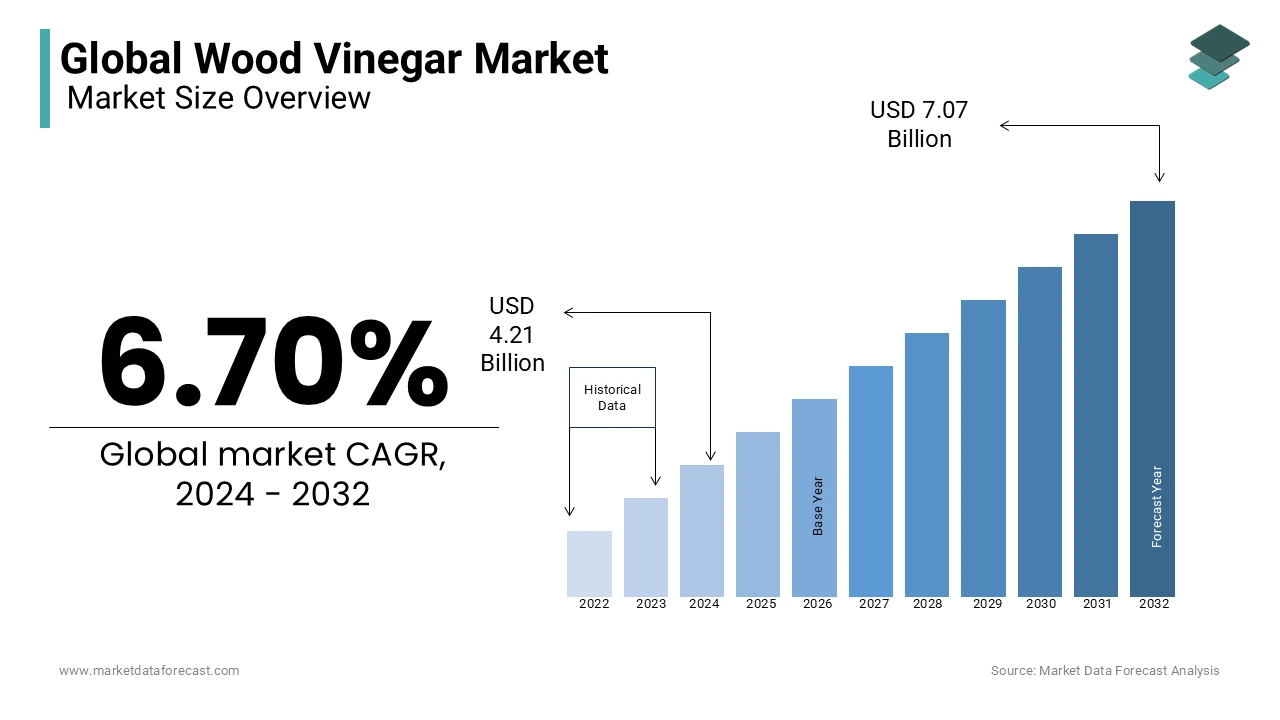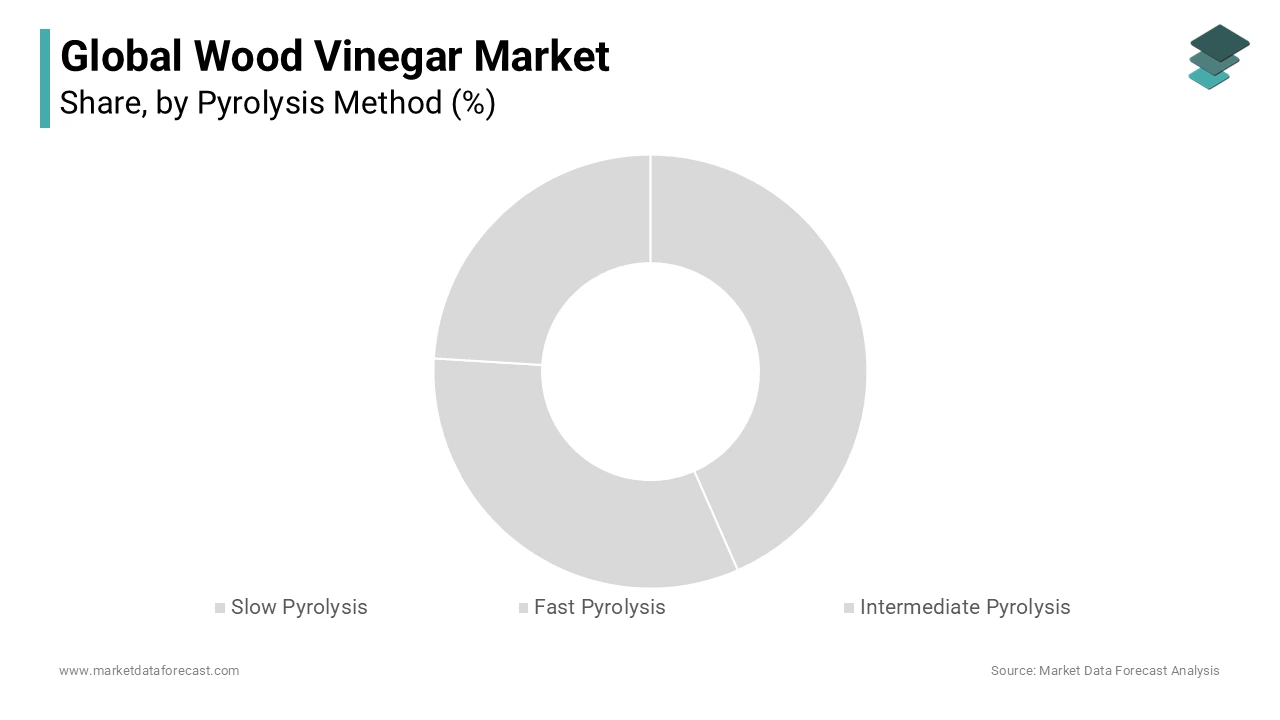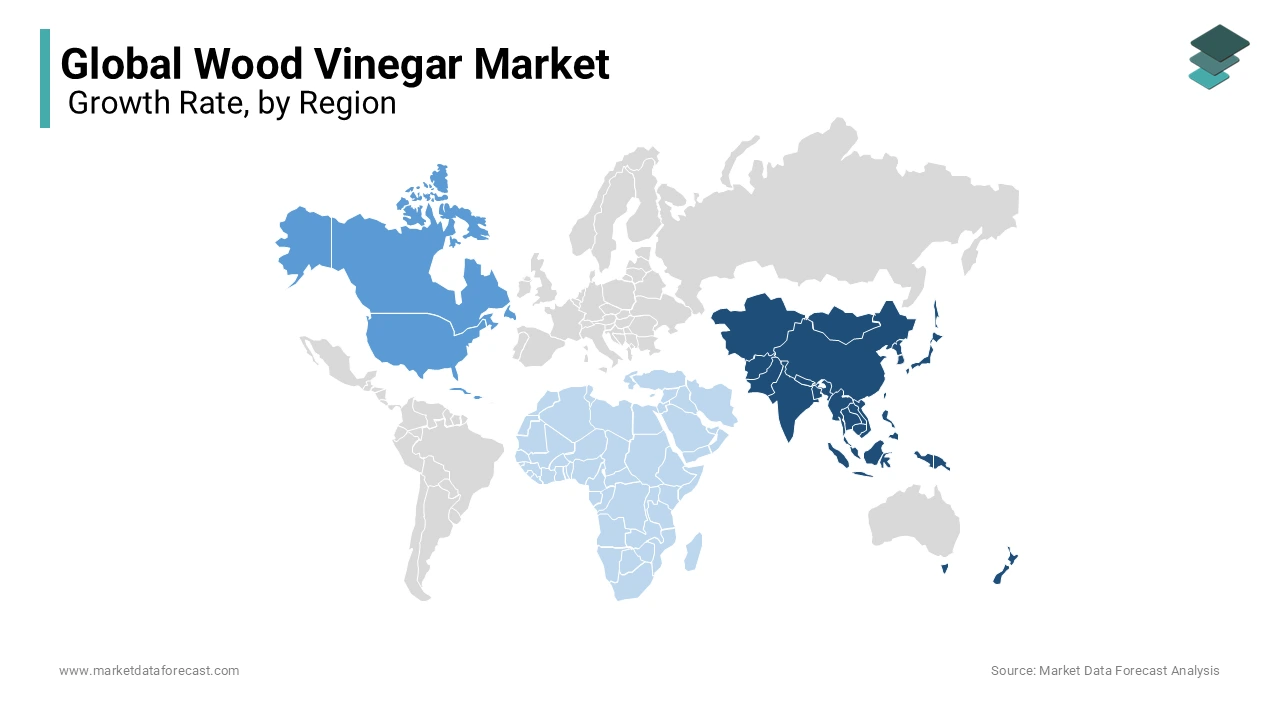Global Wood Vinegar Market Size, Share, Trends & Growth Forecast Report - Segmented By Pyrolysis Method (Slow Pyrolysis, Fast Pyrolysis, And Intermediate Pyrolysis), Application (Agriculture, Animal Feed, Food, Medicinal, And Consumer Products), And Region (North America, Europe, APAC, Latin America, Middle East And Africa) – Industry Analysis From 2025 To 2033
Global Wood Vinegar Market Size
The global wood vinegar market size is worth USD 4.21 billion in 2024, and is anticipated to be worth USD 7.54 billion by 2033 from USD 4.49 billion In 2025, growing at a CAGR of 6.70% during the forecast period.

Wood vinegar is known as pyrolysis acid in chemistry. Wood vinegar is used in organic agriculture because it is used as a bio fertilizer and bio pesticide. It was first investigated by the German chemist Johann Rudolph Glauber. It is a brown-scented liquid created by distilling wood and other plant materials in the absence of air. The main chemical components of pyrolysis acid are acetic acid, formaldehyde, and methanol. Multiple kinds of wood are used to create various types of wood vinegar, including eucalyptus, oak, bamboo, mangrove, coconut husk, and apple. Wood vinegar or pyrolysis acid is a carbon derivative. It is a dark liquid obtained by carbonization by heating biomass in a closed container. The smoke from charcoal making is cooled with liquid and then separated into tar and bio-oil. Wood vinegar comprises approximately 80% to 90% water and more than 200 organic compounds, often including phenol, acetic acid, ketones, esters, formic acid, and methanol.
CURRENT SCENARIO OF THE GLOBAL WOOD VINEGAR MARKET
Market demand for wood vinegar will likely skyrocket as consumer acceptance increases worldwide. The rapid expansion of organic agriculture in the Asia Pacific region is expected to increase the market further in the coming years. The various advantages of wood vinegar have been prominently driving the global market in recent periods. The increased adoption of wood vinegar in agriculture, animal husbandry, and the food industry is accelerating market growth. Expanding these sectors will provide significant growth opportunities to the market during the forecast period. The growing acceptance of wood vinegar as a biopesticide and biofertilizer in agriculture is escalating the market due to enhancing demand for organic products. The widening support of the government in utilizing organic products in the food, cosmetic, and agriculture industries expands the growth opportunities for the wood vinegar market. The rising consumer demand for organic and natural products is increasing significantly, escalating the demand from multiple industries, and is estimated to ensure substantial market growth in the coming years.
MARKET DRIVERS
There is a growing need around the world for soil fertility resistant to pesticides and chemical pesticides that improve the natural feeding of animals.
Various advantages of wood vinegar contribute to the expansion of the global market revenue as it is produced through sustainable methods that can be used not only as animal feed but also as an organic pesticide that has been proven an attractive alternative to synthetic chemicals. Most Asian countries have set renewable energy targets that encourage the production and use of biomass energy, which positively impacts market growth. Pyrolyne acid is a bi-product produced from the biomass pyrolysis method, and the company has recently started commercial sales of pyroligneous acid due to its wide application in various sectors such as agriculture, livestock, pharmaceutical, and cosmetic industries, which is expanding the wood vinegar market. Growth in the global wood vinegar market over the forecast period is supposed to accelerate as demand increases in various industries. The growth of the pharmaceutical and food
industry worldwide is assumed to have a remarkable impact on the global wood vinegar business. Additionally, the surge in the cosmetics and personal care industry is expected to stir demand for this product in the future. Increasing government regulations on using chemicals for crop protection, improved crop yields and increased adoption of organic foods among individuals are key factors driving global Wood Vinegar Market growth during the outlook period.
Furthermore, the mounting urge for wood vinegar in end-users like pharmaceuticals and cosmetics is another factor driving growth in the worldwide market. In addition, increasing the use of wood vinegar in various industries, increasing cost-effective manufacturing, and increasing the application of wood vinegar in the food business to improve the aroma, color, and firmness of vinegar are essential factors in supporting this market's future growth. The presence of various benefits of wood vinegar in the formulation of anti-aging, anti-wrinkle creams is expected to spur market growth in the coming years. The wide adoption of wood vinegar in the food industry, as it works as a natural preservative and flavor enhancer, is expanding the growth opportunities for wood vinegar. Livestock bearers widely accept wood vinegar as it is considered a crucial animal feed supplement due to its ability to maintain the quality of the meat by lowering the cholesterol, accelerating the market size growth.
MARKET RESTRAINTS
The presence of government restrictions on the production and distribution of coal and its derivatives limits overall coal production and the production of the wood vinegar market.
Additionally, the necessity of more trees for charcoal originates from natural forests, leading to logging. Various challenges are associated with sourcing and manufacturing wood vinegar from these similar natural sources; limiting its use in various industrial sectors hampers expanding the global market. Charcoal production is one of the leading causes of deforestation worldwide, which raises environmental concerns and regulations limiting the adoption of wood vinegar, which restricts the market revenue. The need for awareness regarding the benefits of wood vinegar and its extraction methods across underdeveloped and developing regions is hindering global market expansion.
REPORT COVERAGE
|
REPORT METRIC |
DETAILS |
|
Market Size Available |
2024 to 2033 |
|
Base Year |
2024 |
|
Forecast Period |
2025 to 2033 |
|
CAGR |
6.70% |
|
Segments Covered |
By Pyrolysis Method, Application, And Region |
|
Various Analyses Covered |
Global, Regional and Country Level Analysis; Segment-Level Analysis; DROC; PESTLE Analysis; Porter’s Five Forces Analysis; Competitive Landscape; Analyst Overview of Investment Opportunities |
|
Regions Covered |
North America, Europe, APAC, Latin America, Middle East & Africa |
|
Market Leaders Profiled |
Canada Renewable Bioenergy Corp, Net Energy BV (Netherlands), ACE (Singapore) Pte Ltd, TAGROW CO., LTD. (China), and Byron Biochar (Australia) |
SEGMENTAL ANALYSIS
Global Wood Vinegar Market Analysis By Pyrolysis Method

The slow pyrolysis segment dominated the global market revenue with a significant share due to its various advantages in quality and applications. The slow pyrolysis involves controlled wood heating at lower temperatures, resulting in high-quality wood vinegar, rich in organic components. Wood vinegar extracted by slow pyrolysis is considered premium and is mainly used in food, cosmetics, and pharmaceutical industries due to its pure form. These advantages of slow pyrolysis are leading to segment growth. The slow pyrolysis wood vinegar has a more potent aroma and flavor, which is highly preferred as a preservative and flavoring agent in the food industry, fueling market growth.
Global Wood Vinegar Market Analysis By Application
The agriculture segment dominates the global market revenue due to the broad benefits of wood vinegar in the agriculture sector. Wood vinegar possesses various properties, such as biopesticide and enhancing soil fertility, which are significant factors driving the segment growth. The increasing demand for alternatives to chemical fertilizers, pesticides, and wood vinegar as promising biopesticides is augmenting market growth. Wood vinegar can be used for crop protection and crop enrichment, which fuels market growth through wide adoption. Wood vinegar helps overall plant growth as it enhances root development and nutrient uptake, resulting in healthier and more productive crops and propelling the market revenue in the agriculture sector.
REGIONAL ANALYSIS

By region, we estimate the largest market share in revenue in the Asia Pacific region. The industry is expected to be driven by the growing demand for pesticides and biofertilizers in countries like India, China, and Japan; according to the Ministry of Statistics and Program Implementation, India's share of the net area under organic farming increased from 1.39% to 2.45% by the financial year 2022 from the past four years. Population growth and rapid westernization in the Asia-Pacific area are leading to increased intake of meat products. This is expected to intensify the usage of processed meat products, promoting the need for wood vinegar to provide flavor and preservation, leading to regional market growth.
North America is estimated to grow significantly in the coming years. This is primarily due to the demand for wood vinegar in animal feed products, and feed additives have increased the development of the wood vinegar market in North America.
The European region is estimated to have a moderate growth rate during the forecast period due to growing awareness regarding the benefits of wood vinegar in the food, cosmetic, and pharmaceutical industries.
The Middle East and Africa are foreseen to grow significantly due to increased demand for organic products and strict environmental regulations. In addition, as the implementation of wood vinegar in agriculture is anticipated to increase for the development of disease-resistant crops, root stimulation, improved seed germination, and soil enrichment, the demand for wood vinegar will increase in the region.
KEY PLAYERS IN THE GLOBAL WOOD VINEGAR MARKET
Major Key Players in the global wood vinegar market are Canada Renewable Bioenergy Corp, Net Energy BV (Netherlands), ACE (Singapore) Pte Ltd, TAGROW CO., LTD. (China), and Byron Biochar (Australia)
RECENT HAPPENINGS IN THE MARKET
- In April 2023, The Shire of Collie in Western Australia partnered with a startup to build a $10.4 million energy-from-waste plant that converts household rubbish and biomass into biochar, pyrolysis oil, and wood vinegar. This project, developed by Curtin University, aims to create a new bioenergy industry in Collie and has received government and private investment support.
- In December 2022, PyroAg, a leading wood vinegar producer, reduced its prices, asking organic farmers in Australia to embrace sustainable farming practices in the Australian agricultural sector.
- In June 2022, two chemists in the northern Gaza Strip developed a device for extracting wood vinegar, which solves issues related to soil fertility.
- In April 2022, A Japanese Company, Kirin Holdings, launched a new line of canned cocktails that uses wood vinegar as a flavor enhancer.
- Japan-based Mizkan Group has acquired the Sarsos and Dufrais wood vinegar businesses from British food manufacturers. These manufacturers offer premium food that supports the targeted production capacity of the North American vinegar market.
DETAILED SEGMENTATION OF GLOBAL WOOD VINEGAR MARKET INCLUDED IN THIS REPORT
This research report on the global wood vinegar market has been segmented and sub-segmented based on pyrolysis method, application, & region.
By Pyrolysis Method
- Slow Pyrolysis
- Fast Pyrolysis
- Intermediate Pyrolysis
By Application
- Agriculture
- Animal Feed
- Food, Medicinal, and Consumer Products
- Others
By Region
- North America
- Europe
- Asia Pacific
- Latin America
- Middle East and Africa
Frequently Asked Questions
1. What are the applications of wood vinegar?
Wood vinegar has a wide range of applications, including agriculture (as a biopesticide, fertilizer enhancer, and growth promoter), animal husbandry (as a feed additive and odor neutralizer), food processing (as a flavor enhancer and preservative), and various industrial processes.
2. What are the benefits of using wood vinegar in agriculture?
Wood vinegar can improve soil fertility, enhance plant growth, suppress pests and diseases, and reduce the need for synthetic fertilizers and pesticides, thus promoting sustainable agriculture practices.
3. What factors influence the price of wood vinegar?
Factors such as the cost of raw materials (wood), production methods, market demand, quality standards, and regulatory requirements can influence the price of wood vinegar.
Related Reports
Access the study in MULTIPLE FORMATS
Purchase options starting from $ 2500
Didn’t find what you’re looking for?
TALK TO OUR ANALYST TEAM
Need something within your budget?
NO WORRIES! WE GOT YOU COVERED!
Call us on: +1 888 702 9696 (U.S Toll Free)
Write to us: [email protected]